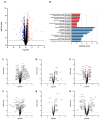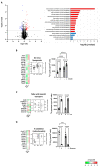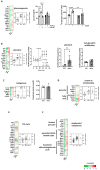Adaptation of Oxidative Phosphorylation Machinery Compensates for Hepatic Lipotoxicity in Early Stages of MAFLD
- PMID: 35743314
- PMCID: PMC9224893
- DOI: 10.3390/ijms23126873
Adaptation of Oxidative Phosphorylation Machinery Compensates for Hepatic Lipotoxicity in Early Stages of MAFLD
Abstract
Alterations in mitochondrial function are an important control variable in the progression of metabolic dysfunction-associated fatty liver disease (MAFLD), while also noted by increased de novo lipogenesis (DNL) and hepatic insulin resistance. We hypothesized that the organization and function of a mitochondrial electron transport chain (ETC) in this pathologic condition is a consequence of shifted substrate availability. We addressed this question using a transgenic mouse model with increased hepatic insulin resistance and DNL due to constitutively active human SREBP-1c. The abundance of ETC complex subunits and components of key metabolic pathways are regulated in the liver of these animals. Further omics approaches combined with functional assays in isolated liver mitochondria and primary hepatocytes revealed that the SREBP-1c-forced fatty liver induced a substrate limitation for oxidative phosphorylation, inducing enhanced complex II activity. The observed increased expression of mitochondrial genes may have indicated a counteraction. In conclusion, a shift of available substrates directed toward activated DNL results in increased electron flows, mainly through complex II, to compensate for the increased energy demand of the cell. The reorganization of key compounds in energy metabolism observed in the SREBP-1c animal model might explain the initial increase in mitochondrial function observed in the early stages of human MAFLD.
Keywords: fatty liver; hepatic metabolism; mitochondria; substrate; subunit.
Conflict of interest statement
The authors declare no conflict of interest. The funders had no role in the design of the study; in the collection, analyses, or interpretation of data; in the writing of the manuscript; or in the decision to publish the results.
Figures








Similar articles
-
E4BP4 is an insulin-induced stabilizer of nuclear SREBP-1c and promotes SREBP-1c-mediated lipogenesis.J Lipid Res. 2016 Jul;57(7):1219-30. doi: 10.1194/jlr.M067181. Epub 2016 Jun 1. J Lipid Res. 2016. PMID: 27252523 Free PMC article.
-
Dietary α-lactalbumin induced fatty liver by enhancing nuclear liver X receptor αβ/sterol regulatory element-binding protein-1c/PPARγ expression and minimising PPARα/carnitine palmitoyltransferase-1 expression and AMP-activated protein kinase α phosphorylation associated with atherogenic dyslipidaemia, insulin resistance and oxidative stress in Balb/c mice.Br J Nutr. 2017 Dec;118(11):914-929. doi: 10.1017/S000711451700232X. Epub 2017 Nov 27. Br J Nutr. 2017. PMID: 29173234
-
GRP78 expression inhibits insulin and ER stress-induced SREBP-1c activation and reduces hepatic steatosis in mice.J Clin Invest. 2009 May;119(5):1201-15. doi: 10.1172/JCI37007. Epub 2009 Apr 13. J Clin Invest. 2009. PMID: 19363290 Free PMC article.
-
Hepatic steatosis: a role for de novo lipogenesis and the transcription factor SREBP-1c.Diabetes Obes Metab. 2010 Oct;12 Suppl 2:83-92. doi: 10.1111/j.1463-1326.2010.01275.x. Diabetes Obes Metab. 2010. PMID: 21029304 Review.
-
SREBP-1c and TFE3, energy transcription factors that regulate hepatic insulin signaling.J Mol Med (Berl). 2007 May;85(5):437-44. doi: 10.1007/s00109-007-0158-5. Epub 2007 Feb 6. J Mol Med (Berl). 2007. PMID: 17279346 Review.
Cited by
-
MAFLD as part of systemic metabolic dysregulation.Hepatol Int. 2024 Oct;18(Suppl 2):834-847. doi: 10.1007/s12072-024-10660-y. Epub 2024 Apr 9. Hepatol Int. 2024. PMID: 38594474 Review.
-
Increasing cellular NAD+ protects hepatocytes against palmitate-induced lipotoxicity by preventing PARP-1 inhibition and the mTORC1-p300 pathway activation.Am J Physiol Cell Physiol. 2025 Mar 1;328(3):C776-C790. doi: 10.1152/ajpcell.00946.2024. Epub 2025 Jan 27. Am J Physiol Cell Physiol. 2025. PMID: 39871470 Free PMC article.
-
Chronic stress alters hepatic metabolism and thermodynamic respiratory efficiency affecting epigenetics in C57BL/6 mice.iScience. 2024 Feb 20;27(3):109276. doi: 10.1016/j.isci.2024.109276. eCollection 2024 Mar 15. iScience. 2024. PMID: 38450153 Free PMC article.
-
Hepatic Mitochondria-Gut Microbiota Interactions in Metabolism-Associated Fatty Liver Disease.Metabolites. 2023 Feb 21;13(3):322. doi: 10.3390/metabo13030322. Metabolites. 2023. PMID: 36984762 Free PMC article. Review.
-
NAFLD/MAFLD: New Evidence.Int J Mol Sci. 2023 Apr 14;24(8):7241. doi: 10.3390/ijms24087241. Int J Mol Sci. 2023. PMID: 37108404 Free PMC article.
References
-
- Knebel B., Haas J., Hartwig S., Jacob S., Kollmer C., Nitzgen U., Muller-Wieland D., Kotzka J. Liver-specific expression of transcriptionally active SREBP-1c is associated with fatty liver and increased visceral fat mass. PLoS ONE. 2012;7:e31812. doi: 10.1371/journal.pone.0031812. - DOI - PMC - PubMed
-
- Knebel B., Fahlbusch P., Dille M., Wahlers N., Hartwig S., Jacob S., Kettel U., Schiller M., Herebian D., Koellmer C., et al. Fatty Liver Due to Increased de novo Lipogenesis: Alterations in the Hepatic Peroxisomal Proteome. Front. Cell Dev. Biol. 2019;7:248. doi: 10.3389/fcell.2019.00248. - DOI - PMC - PubMed
MeSH terms
Substances
Grants and funding
LinkOut - more resources
Full Text Sources
Molecular Biology Databases

